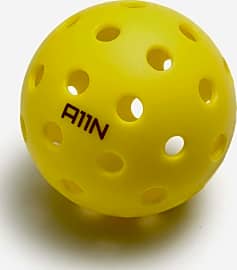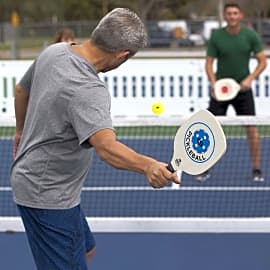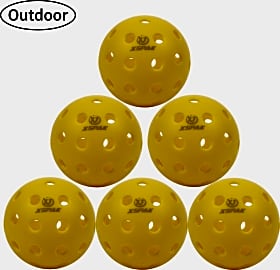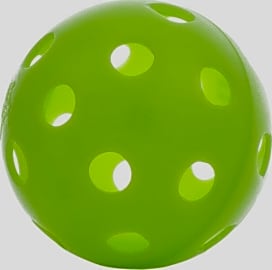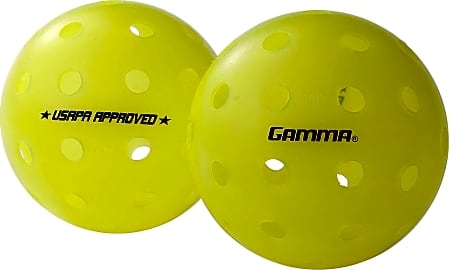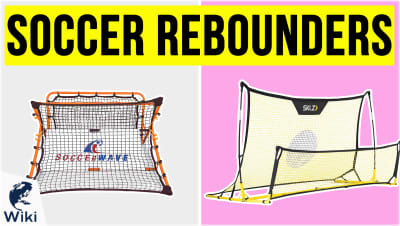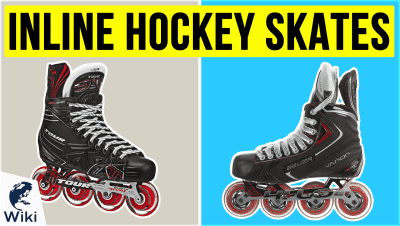The 9 Best Pickleballs

This wiki has been updated 38 times since it was first published in January of 2017. Like tennis and badminton, pickleball is an entertaining way for folks of any age or skill level to get a little exercise, have fun and engage in some friendly competition. That being said, the game is more enjoyable — and more competitive — if you play with the proper gear. These selections will help get you started with the sport on the right foot or sharpen your existing skills. When users buy our independently chosen editorial choices, we may earn commissions to help fund the Wiki.
Editor's Notes
June 10, 2021:
For the most part, pickleballs haven't changed for a long time, and our rankings haven't changed much, either. We did recently eliminate an Onix model that we already weren't huge fans of, and which now is tough to get your hands on, but the Onix Pure 2 Outdoor remains the top high-visibility model for outdoor use. Overall, though, the Wiki is largely the same as it was after our previous update.
January 03, 2020:
We learned that the Tourna Outdoor don’t possess the requisite durability for outdoor play — they tend to wear down quickly, often breaking apart at the seams. We removed them from the list. Reports also indicated that the Onix Pure 2 Indoor can be difficult to see in some environments, so we downgraded that item a bit.
We added three models that provide a choice between indoor and outdoor balls, while the other option we inserted into the list is designed to work both outside and on gym courts. All the new additions weigh between 0.8 and 0.93 ounces.
We noted that the EasyTime Flight come with a carton for storage, which is a useful add-on. The A11N Premium are a bit thicker than most balls, which allows them to perform well in windy conditions.
Special Honors
RiverStyks 9 Pack Getting bored with the same old yellow, green and orange pickleballs? With these vibrant balls from RiverStykes, you’ll be the talk of the court. They come in a variety of solid color and bi-color styles, from bright pink to an oddly enticing green-and-purple combo. riverstyks.com
Serving Excitement And Action With Every Stroke
The game consists of either two or four players equipped with wood paddles that are used to hit a perforated polymer ball over a net.
Whether your kids want something fun and unique to play or you're a dedicated athlete looking for the next challenge, a competitive game of pickleball may be just the ticket when it comes to setting your game time apart from more traditional sports. That said, if you're aspiring to become the Serena Williams of this sport, then you'll need a dependable set of pickleballs to ensure you get the most out of each match.
Combining various elements of tennis, table tennis, and badminton, pickleball is a racket sport designed for both indoor and outdoor play. The game consists of either two or four players equipped with wood paddles that are used to hit a perforated polymer ball over a net. The pickleball ball is hollow and similar in both design and shape to that of a Wiffle ball. It is served by an underhand stroke at or below the waist level. The balls are usually available in bright colors that include yellow, neon, white, orange, and lime green, making them easy to spot regardless of where you're playing.
Pickleballs are categorized into both indoor and outdoor varieties. Outdoor pickleballs are engineered using a rotational molding process during which plastic resin is heated, melted, and rotated at an even speed into a spherical shape. This process essentially allows a ball's plastic to be laid down in multiple layers of the same thickness. Once this plastic has cooled, a series of holes are then drilled into the ball's surface. Depending on the brand, these drilled holes can vary in size or they can all be identical. Variations in hole size help make the ball more aerodynamic when dealing with extreme weather conditions. Outdoor pickleballs weigh around 0.88 ounces and offer a thick-walled construction for superior durability on the court.
By contrast, many indoor pickleballs are made through an injection molding process during which the plastic is melted and slowly forced into a stationary mold under high pressure, ensuring a smooth feel. They are optimized for use on wood, tile, and cement surfaces. Their holes are usually large in diameter to accept even greater airflow, as they don't have to contend with the forces of wind. Indoor balls also have a slightly-textured surface to help increase their bouncing abilities. Being softer and lighter than their outdoor counterparts, indoor pickleballs often require a greater amount of striking force to get them to sail over the net.
Finally, it's important to realize that unlike the aerodynamics of a non-perforated tennis ball, the holes in a pickleball will often challenge players to anticipate its range of bounce and movement through the air as it flies back and forth across the court. That being said, regular practice in both indoor and outdoor settings allow players to grow accustomed to the ball's style of motion and spinning, while learning to appreciate (at least partially) its unpredictability when struck with the appropriate paddle.
Keeping Yourself Out Of A Pickle With A Good Pickleball
Just as a tennis ball wears out from the constant impacts of a player's racket to keep it in motion, the performance of a pickleball also decreases over time. Regardless of where you decide to play, both performance and durability should be important considerations. If you're playing outdoors, the plastic should be thick, smooth, and resilient with evenly-spaced holes for maintaining balance and bounce consistency during a match. All of these factors can help you achieve effective game performance by allowing you to master a wide variety of shots with at least some degree of predictability as to a ball's trajectory once it has been hit with a paddle.
Consider a set of pickleballs that offer thick walls and seam welding construction, especially when playing outdoors with friends on a regular basis. Seam welding prevents the balls from splitting, while the internal thickness allows them to withstand heavy impacts during intense competitions.
For indoor use, make sure the drilled holes on your balls of choice have been strategically arranged and are identical in size, as this will keep them balanced as they fly back and forth across the court, while ensuring they maintain their shape over time.
A Brief History Of Pickleball
The history of pickleball dates back to the summer of 1965 and is credited to Washington State congressman Joel Pritchard and businessman Bill Bell. Upon returning to Pritchard's home on Bainbridge Island one Saturday afternoon, the duo found their families sitting around with nothing to do, even though there was a badminton court on the property. After unsuccessfully hunting for badminton equipment, the two decided to improvise by playing on the court with a couple of ping-pong paddles and a perforated ball instead.
After unsuccessfully hunting for badminton equipment, the two decided to improvise by playing on the court with a couple of ping-pong paddles and a perforated ball instead.
The following weekend, Barney McCallum was first introduced to the game at Pritchard's home. Together, the trio of co-founders developed a series of rules, relying heavily on the concept of badminton. Pickleball was born out of this initial collaboration.
But how did the game get its unique name? One of Joel's children, Frank Pritchard, believed that the sport's name may have come from his mother, Joan, who was a competitive rower on the island. She often referred to the slowest boat in a race as a "pickle boat". As Joan watched the game, the action reminded her of the pickle boat in crew where oarsmen were chosen from the leftovers of other boats in the race.
By 1967, the first permanent pickleball court was installed in the yard of Joel Pritchard's next-door neighbor. In the spring of 1976, the world's first pickleball tournament took place at the South Center Athletic Club in Tukwila, Washington. The USA Pickleball Association (USAPA) was established in 1984 along with the first rulebook. That same year, Boeing engineer Arlen Paranto developed the first composite pickleball paddle.
Following the end of the 20th century and up to present day, pickleball remains a nationally-recognized sport with a variety of ball types, colors, and accessories to ensure success on the court.


